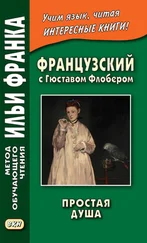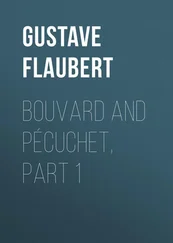They strove to interpret the sculptured symbols on the capitals, such as the two griffins of Marigny pecking at a tree in blossom; Pécuchet read a satire in the singers with grotesque jaws which terminate the mouldings at Feugerolles; and as for the exuberance of the man that covers one of the mullions at Hérouville, that was a proof, according to Bouvard, of our ancestors' love of broad jokes.
They ended by not tolerating the least symptom of decadence. All was decadence, and they deplored vandalism, and thundered against badigeon.
But the style of a monument does not always agree with its supposed date. The semicircular arch of the thirteenth century still holds sway in Provence. The ogive is, perhaps, very ancient; and authors dispute as to the anteriority of the Romanesque to the Gothic. This want of certainty disappointed them.
After the churches they studied fortresses—those of Domfront and Falaise. They admired under the gate the grooves of the portcullis, and, having reached the top, they first saw all the country around them, then the roofs of the houses in the town, the streets intersecting one another, the carts on the square, the women at the washhouse. The wall descended perpendicularly as far as the palisade; and they grew pale as they thought that men had mounted there, hanging to ladders. They would have ventured into the subterranean passages but that Bouvard found an obstacle in his stomach and Pécuchet in his horror of vipers.
They desired to make the acquaintance of the old manor–houses—Curcy, Bully, Fontenay, Lemarmion, Argonge. Sometimes a Carlovingian tower would show itself at the corner of some farm–buildings behind a heap of manure. The kitchen, garnished with stone benches, made them dream of feudal junketings. Others had a forbiddingly fierce aspect with their three enceintes still visible, their loopholes under the staircase, and their high turrets with pointed sides. Then they came to an apartment in which a window of the Valois period, chased so as to resemble ivory, let in the sun, which heated the grains of colza that strewed the floor. Abbeys were used as barns. The inscriptions on tombstones were effaced. In the midst of fields a gable–end remained standing, clad from top to bottom in ivy which trembled in the wind.
A number of things excited in their breasts a longing to possess them—a tin pot, a paste buckle, printed calicoes with large flowerings. The shortness of money restrained them.
By a happy chance, they unearthed at Balleroy in a tinman's house a Gothic church window, and it was big enough to cover, near the armchair, the right side of the casement up to the second pane. The steeple of Chavignolles displayed itself in the distance, producing a magnificent effect. With the lower part of a cupboard Gorju manufactured a prie–dieu to put under the Gothic window, for he humoured their hobby. So pronounced was it that they regretted monuments about which nothing at all is known—such as the villa residence of the bishops of Séez.
"Bayeux," says M. de Caumont, "must have possessed a theatre." They searched for the site of it without success.
The village of Montrecy contained a meadow celebrated for the number of medals which chanced formerly to have been found there. They calculated on making a fine harvest in this place. The caretaker refused to admit them.
They were not more fortunate as to the connection which existed between a cistern at Falaise and the faubourg of Caen. Ducks which had been put in there reappeared at Vaucelles, quacking, "Can, can, can"—whence is derived the name of the town!
No step, no sacrifice, was too great for them.
At the inn of Mesnil–Villement, in 1816, M. Galeron got a breakfast for the sum of four sous. They took the same meal there, and ascertained with surprise that things were altered!
Who was the founder of the abbey of St. Anne? Is there any relationship between Marin Onfroy, who, in the twelfth century, imported a new kind of potato, and Onfroy, governor of Hastings at the period of the Conquest? How were they to procure L'Astucieuse Pythonisse , a comedy in verse by one Dutrezor, produced at Bayeux, and just now exceedingly rare? Under Louis XIV., Hérambert Dupaty, or Dupastis Hérambert, composed a work which has never appeared, full of anecdotes about Argentan: the question was how to recover these anecdotes. What have become of the autograph memoirs of Madame Dubois de la Pierre, consulted for the unpublished history of L'Aigle by Louis Dasprès, curate of St. Martin? So many problems, so many curious points, to clear up.
But a slight mark often puts one on the track of an invaluable discovery.
Accordingly, they put on their blouses, in order not to put people on their guard, and, in the guise of hawkers, they presented themselves at houses, where they expressed a desire to buy up old papers. They obtained heaps of them. These included school copybooks, invoices, newspapers that were out of date—nothing of any value.
At last Bouvard and Pécuchet addressed themselves to Larsoneur.
He was absorbed in Celtic studies, and while summarily replying to their questions put others to them.
Had they observed in their rounds any traces of dog–worship, such as are seen at Montargis, or any special circumstances with regard to the fires on St. John's night, marriages, popular sayings, etc.? He even begged of them to collect for him some of those flint axes, then called celtæ , which the Druids used in their criminal holocausts.
They procured a dozen of them through Gorju, sent him the smallest of them, and with the others enriched the museum. There they walked with delight, swept the place themselves, and talked about it to all their acquaintances.
One afternoon Madame Bordin and M. Marescot came to see it.
Bouvard welcomed them, and began the demonstration in the porch.
The beam was nothing less than the old gibbet of Falaise, according to the joiner who had sold it, and who had got this information from his grand–father.
The big chain in the corridor came from the subterranean cells of the keep of Torteval. In the notary's opinion it resembled the boundary chains in front of the entrance–courts of manor–houses. Bouvard was convinced that it had been used in former times to bind the captives. He opened the door of the first chamber.
"What are all these tiles for?" exclaimed Madame Bordin.
"To heat the stoves. But let us be a little regular, if you please. This is a tomb discovered in an inn where they made use of it as a horse–trough."
After this, Bouvard took up the two urns filled with a substance which consisted of human dust, and he drew the phials up to his eyes, for the purpose of showing the way the Romans used to shed tears in it.
"But one sees only dismal things at your house!"
Indeed it was a rather grave subject for a lady. So he next drew out of a case several copper coins, together with a silver denarius.
Madame Bordin asked the notary what sum this would be worth at the present day.
The coat of mail which he was examining slipped out of his fingers; some of the links snapped.
Bouvard stifled his annoyance. He had even the politeness to unfasten the halberd, and, bending forward, raising his arms and stamping with his heels, he made a show of hamstringing a horse, stabbing as if with a bayonet and overpowering an enemy.
The widow inwardly voted him a rough person.
She went into raptures over the shell chest of drawers.
The cat of St. Allyre much astonished her, the pear in the decanter not quite so much; then, when she came to the chimney–piece: "Ha! here's a hat that would need mending!"
Three holes, marks of bullets, pierced its brims.
It was the head–piece of a robber chief under the Directory, David de la Bazoque, caught in the act of treason, and immediately put to death.
Читать дальше
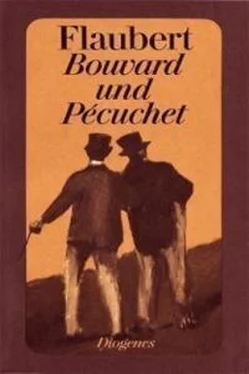
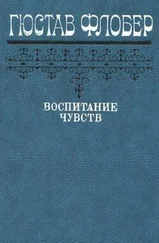

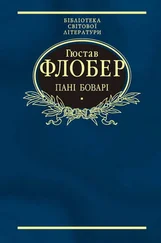
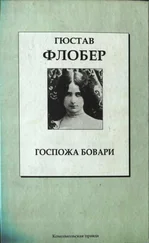
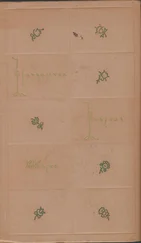
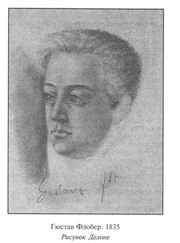
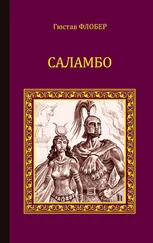
![Гюстав Флобер - Закат Карфагена [Сборник]](/books/414440/gyustav-flober-zakat-karfagena-sbornik-thumb.webp)
